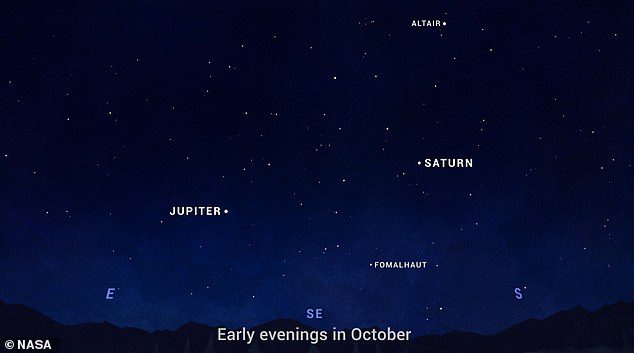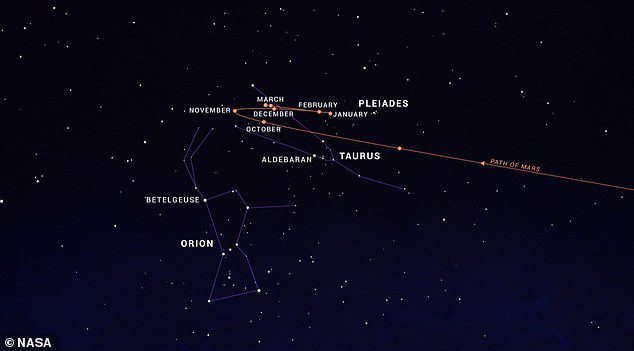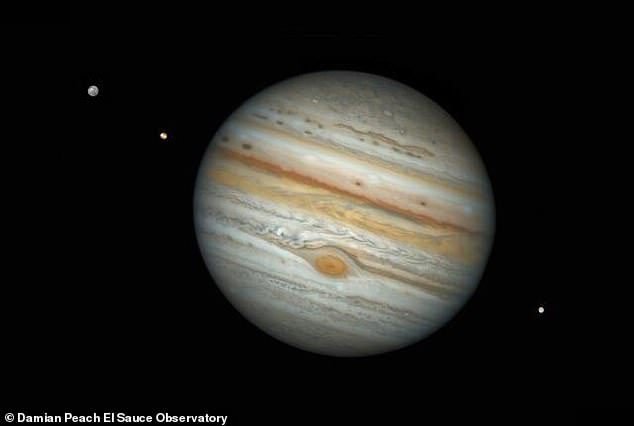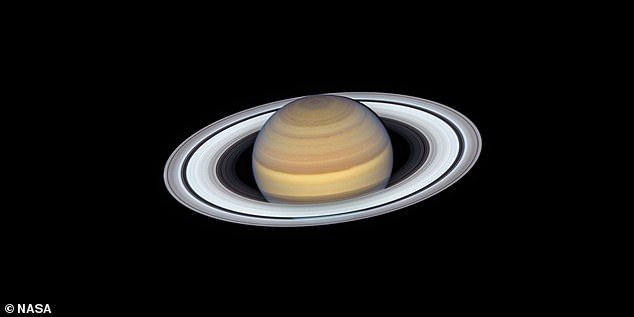NASA is urging stargazers to enjoy Evenings with the Giants this month — the massive planets Jupiter and Saturn will appear in the night sky over the next few weeks.
Early in the evening, you’ll find them in the southeast, slowly moving west with the stars throughout the night.
“They form a triangle with the bright star Fomalhaut,” the US space agency explained on its website.
Observing this trio, notice how the planets sparkle with a steady light, while the star twinkles. This can be an easy way to tell if what you’re looking for is a planet or a star.
At the end of last month, astronomers revealed that Jupiter will appear at its largest and brightest in decades, as it neared its closest point to Earth in 59 years.
It’s still about 367 million miles away from us, but not since October 1963 stargazers have had a great chance of spotting them in the night sky.

Look for! NASA is urging stargazers to enjoy Evenings with the Giants this month — the massive planets Jupiter and Saturn will appear in the night sky over the next few weeks. “They form a triangle with the bright star Fomalhaut,” the US space agency explained on its website.

Astronomers may also be able to observe the retrograde motion of Mars this month. The sky chart above shows the path of the Red Planet over several months in 2022 and 2023 as it enters, and then exits, in retrograde motion
The gas giant approached the Earth almost 60 years ago on September 25, and after 24 hours it reached opposition, which means that the planet appeared opposite the Sun to those on Earth.
The closest approach to the planet from Earth rarely matches the opposition, which NASA said means this year’s sightings will be “exceptional.”
The overlap between the two events, which won’t happen again until 2139, means that Jupiter will appear brighter and larger in the sky over the next few weeks.
When it comes to other celestial sightings this month, Mars has been steadily making its way eastward throughout the year as it normally does, relative to the background stars.
But at the end of October, the red planet stopped this apparent movement, and then seemed to reverse course.
For the next three months, from November to late January, the planet moves westward every night, then toward the end of January it reverses direction again and continues its journey east.
NASA said this is the so-called retrograde motion of Mars.
“It happens about every two years, and it has thrown early observers into a vicious circle,” the US space agency wrote.
It seems that Mars is changing its direction is an illusion caused by the motions of our planet in its orbit, passing through the red planet in its orbit.
Earth and Mars are on nearly circular tracks around the sun, like cars on a racetrack, but our planet Earth is on the fastest inner track.
About every 26 months, we pass Mars, which is moving slower in its orbit. During that period when we are passing through Mars, and before we go around the bend in our orbit to get away from it, we see Mars in retrograde, and it seems to change direction, even though it is still moving forward in its orbit.
Amateur astronomers were asked to take notes on how the position of Mars with respect to Betelgeuse, Aldebaran, and Pleiades changed over the course of the weeks.
“You will witness what was once a source of intense curiosity for astronomers, but we now know it’s just a sign of two planets passing by at night,” NASA added.

At the end of last month, astronomers revealed that Jupiter will appear at its largest and brightest in decades, as it neared its closest point to Earth in 59 years.

Stars: Early in the evening, you’ll find Jupiter and Saturn (shown) to the southeast of the sky, slowly moving toward the west with the stars throughout the night
The Orionid meteor is also active throughout October and November, peaking on the night of October 20.
It is a moderate shower, usually producing 10-20 meteors per hour at its peak, under clear and dark skies.
The bad news is that this year the moon will be 20 percent full on peak nights, so it will interfere a bit when it rises two hours before dawn.
However, it should not spoil the view completely.
The shower’s name comes from the fact that you can trace the tracks of its meteors to an area in the sky near Orion.
These meteorites are fragments of dust left behind by Comet Halley in a path that extends along its orbit. They tend to be bright and fast-moving, often leaving static traces that can glow in the sky for a few seconds after you pass them.
No special equipment is needed to monitor meteor showers.
Just make sure you’re warm enough, and look from a safe, dark place away from bright lights. Then all you have to do is search and enjoy the show,” the US space agency said.

“Beer aficionado. Gamer. Alcohol fanatic. Evil food trailblazer. Avid bacon maven.”
